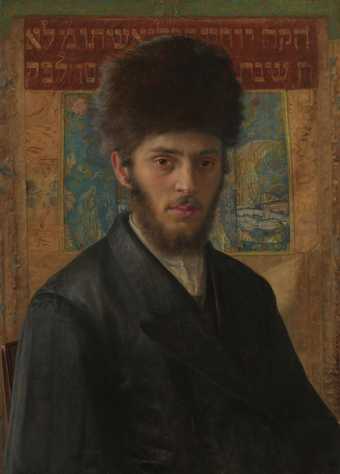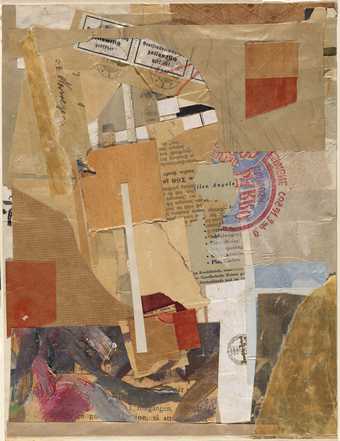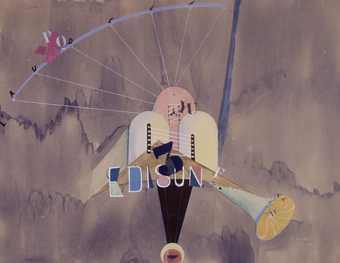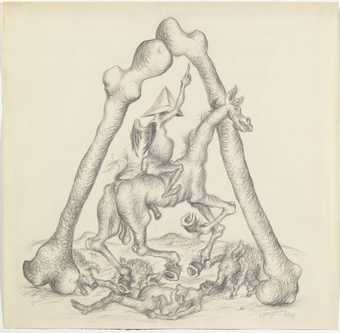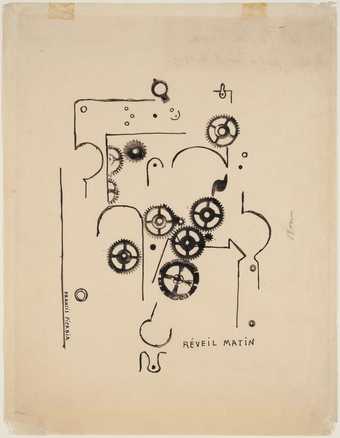
Not on display
- Artist
- Raoul Hausmann 1886–1971
- Original title
- Der Kunstkritiker
- Medium
- Lithograph and printed paper on paper
- Dimensions
- Support: 318 × 254 mm
- Collection
- Tate
- Acquisition
- Purchased 1974
- Reference
- T01918
Display caption
Hausmann, a founder member of the Berlin Dada group, developed photomontage as a tool of satire and political protest. Although the 'art critic' is identified by a stamp as George Grosz, another member of the group, the image was probably an anonymous figure cut from a magazine. The fragment of a German banknote behind the critic’s neck suggests that he is controlled by capitalist forces. The words in the background are part of a poem poster made by Hausmann to be pasted on the walls of Berlin.
Gallery label, September 2006
Does this text contain inaccurate information or language that you feel we should improve or change? We would like to hear from you.
Catalogue entry
Raoul Hausmann 1886-1971
T01918 The Art Critic
1919-20
Inscribed on the back 'No.16' and 'Der Kunstkritiker'
Photomontage, 12 1/2 x 10 (31.7 x 25.4)
Purchased from Frau Ilse Vordemberge-Leda through Annely Juda Fine Art (Grant-in-Aid) 1974
Prov:
Friedrich Vordemberge-Gildewart, Hanover (by 1925); Frau Ilse Vordemberge-Leda, Rapperswil
Exh:
Erste internationale Dada-Messe, Kunsthandlung Dr. Otto Burchard, Berlin, June 1920 (37) as 'Der Kunstreporter'; Dada, Kunsthaus, Zurich, October-November 1966 (112); Musée National d'Art Moderne, Paris, November 1966-January 1967 (112); Raoul Hausmann, Moderna Museet, Stockholm, October-November 1967 (16, repr.); Combattimento per un'Immagine: Fotografi e Pittori, Galleria Civica d'Arte Moderna, Turin, March-April 1973 (works not listed, repr.); Dada and Surrealism Reviewed, Hayward Gallery, London, January-March 1978 (4.42, repr. in colour); Paris-Berlin 1900-1933, Centre National d'Art et de Culture Georges Pompidou, Musée National d'Art Moderne, Paris, July-November 1978 (works not numbered, repr.)
Lit:
Michel Giroud (ed.), Raoul Hausmann 'Je ne suis pas un Photographe' (Paris 1975), p.48, repr. p.49 in colour
Repr:
Jean-François Bory, Prolégomènes à une Monographie de Raoul Hausmann
(Paris 1972), n.p. (dated 1919); Raoul Hausmann, Am Anfang war Dada
(Steinbach-Giessen 1972), p.94 (dated 1919)
According to Michel Giroud, loc. cit., this is an 'ironic photomontage depicting the critic as exclusively preoccupied with fashion and women and whose analyses are no more than successions of words without meaning ... His portrait is stuck onto the background of a poem-poster whose huge letters speak the new language, which is beyond the understanding of the blinded critic.'
The main figure is stamped 'Porträt | CONSTRUIERT | George Grosz 1920' (portrait - constructed - of George Grosz 1920) and its head looks to the compiler as though it may have been a magazine photograph of Grosz himself. Prof. Dr. Walter Huder of the George-Grosz-Archiv in Berlin writes that he has compared it with a number of photographs of Grosz of the same period and that the hair, nose and chin appear identical. On the other hand Grosz's son Peter Grosz considers that it does not look like him as he was in 1920 but has a vague resemblance to Richard Huelsenbeck, though the newspaper silhouette of the man on the right in the rather dandified posture could be Grosz. The substitution of new eyes and a new mouth to suggest prejudice, lack of understanding and venom (an impression of corruption which is reinforced by the fragment of a German banknote which appears to penetrate the critic's neck from the back like a dagger) makes the head, no doubt deliberately, somewhat difficult to identify. To the compiler, a comparison with the photograph of Grosz (which is like) and of Richard Huelsenbeck (which is unlike) reproduced in Der Dada No.3
published in 1920 makes a connection with Grosz much the more likely, though one would expect a magazine photograph of Grosz to have been recorded.
The two artists were very close at this period and made several works in collaboration. Moreover Grosz stamped a number of his own works of 1920 with various rubber stamps of a similar kind bearing inscriptions such as 'GEORGE GROSZ | 1920 | CONSTRUIERT' and 'CONSTRUIERT | George Grosz 1920' (though never, as far as the compiler is aware, one inscribed 'Porträt | CONSTRUIERT | George Grosz 1920'). It may be that the photograph was not of Grosz himself but was chosen because of its resemblance to him, and that either Grosz or Hausmann afterwards inscribed it, perhaps ironically, with one of Grosz's stamps, suitably adapted.
Mrs Vera Cohn, who knew Hausmann from 1928 to about 1934-5, has suggested that the woman, whose photograph was also cut out of some magazine, was possibly an actress or film star of the period - by her type of hair style and make-up certainly not a member of Hausmann's circle - and that the shadowy silhouette could have been intended to signify the shadow of the bourgeoisie. The background seems to be the right-hand half of one of Hausmann's phonetic poem-posters made to paste up on walls in Berlin, and the two rows of lettering on it (legible in their entirety from the back) read 'bcnokis | ethnolu'. The only two posters which are known to survive intact have very similar typography and are both printed on coloured paper, one like this on orange-brick paper and the other on green paper. Both measure 32.5 x 47.5cm, that is to say nearly twice the width of this work.
The printed caption on the right reads:
RAOUL HAUSMANN
PRÄSIDENT DER SONNE,
DES MONDES UND DER KLEINEN ERDE (INNENFLÄCHE)
DADASOPH DADARAOUL, DIREKTOR DES CIRKUS DADA
This can be translated as 'Raoul Hausmann president of the sun, the moon and the little earth (inner surface) Dadasoph Dadaraoul, director of the Dada circus'. Just as Hausmann called himself Dadasoph, so Johannes Baader was known as Oberdada, and the six artists Baader, Grosz, Hausmann, Heartfield, Huelsenbeck and Mehring collectively as the Urdadas. In an article in Der Dada No.2, Baader describes himself with a similar ironic extravagance as 'Oberdada, president of the globe of the earth and the world, head of world justice, acting confidential chairman of the intertellurian oberdadaistic League of Nations of DADACO.'
Though this photomontage has usually been dated 1919, the date on the stamp 'Porträt CONSTRUIERT George Grosz' is 1920, and 1920 is mentioned again in the newspaper cutting collaged in on the right.
Published in:
Ronald Alley, Catalogue of the Tate Gallery's Collection of Modern Art other than Works by British Artists, Tate Gallery and Sotheby Parke-Bernet, London 1981, pp.355-6, reproduced p.355
Explore
- emotions, concepts and ideas(16,416)
-
- formal qualities(12,454)
-
- photographic(4,673)
- clothing and personal items(5,879)
-
- shoe(179)
- paintbrush(90)
- money(254)
- individuals: male(1,841)
- social comment(6,584)
-
- corruption(117)
- prejudice(79)
- satire(265)
- inscriptions(6,664)
You might like
-
Isidor Kaufmann Young Rabbi from N.
c.1910 -
Kurt Schwitters Opened by Customs
1937–8 -
Jean Crotti Portrait of Edison
1920 -
André Fougeron Homage to Franco!!!
1937 -
Francis Picabia Alarm Clock
1919

